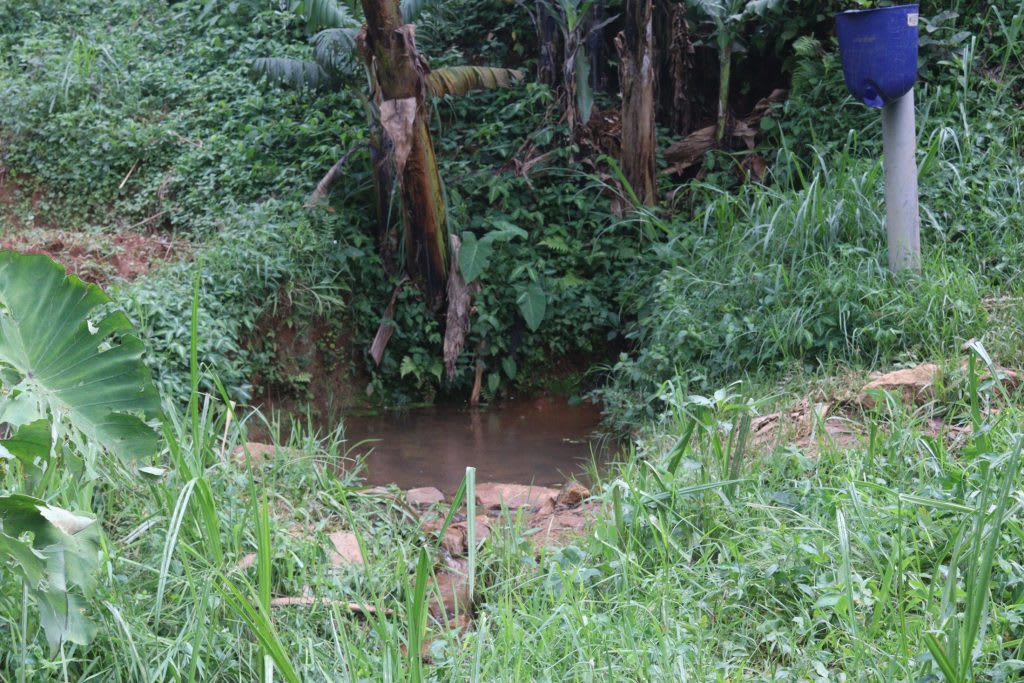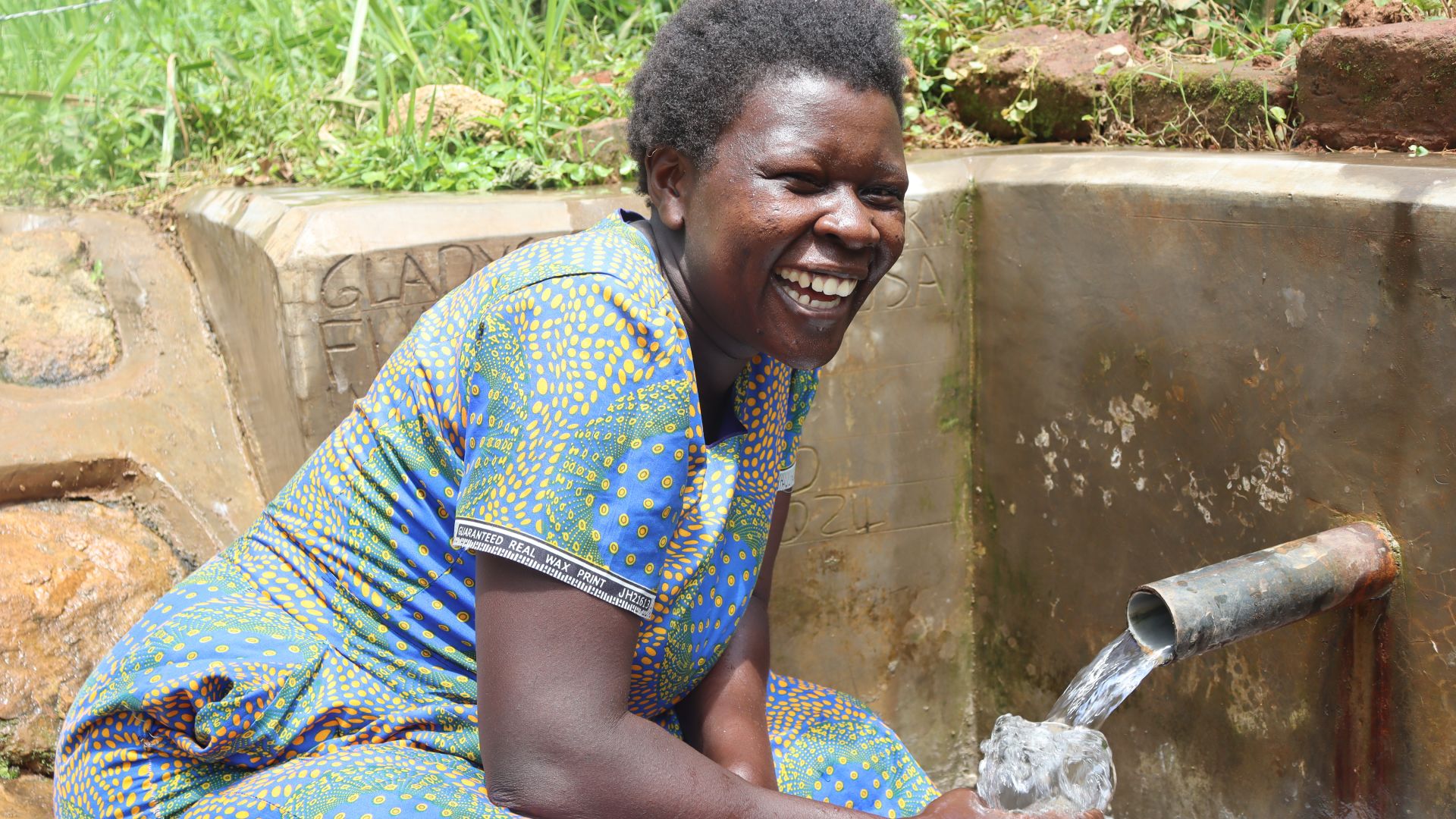August, 2024: Kabinjari Community Spring Protection Complete!
Kabinjari Community now has access to clean water! Thanks to your donation, we transformed their spring into a flowing source of naturally filtered water. We also installed a chlorine dispenser to provide added protection and trained the community on improved sanitation and hygiene practices. Together, these components will unlock the opportunity for community members to live better, healthier lives.

"With access to clean and reliable water, I hope to see a significant improvement in health outcomes for my family and also myself. Clean water is essential for drinking, cooking, and personal hygiene practices like bathing and handwashing. Therefore, this water point will show that there is no need to rely on contaminated sources like we used to. Generally, the risk of getting waterborne diseases will be reduced, thus promoting better health," shared 62-year-old Gladys Musimbi, a local businesswoman.
"Fetching water from the steep and unprotected water spring was incredibly time-consuming and physically demanding. Now that this water point has been constructed, tested, and launched, I hope to reclaim the hours spent walking long distances or waiting in line at the crowded water point. This newfound time will then be redirected towards productive activities such as work, farming, or spending quality time with my family," Gladys continued.

Gladys Musimbi."I have children and also grandchildren. This new waterpoint will make a difference in their lives. Since they have enough clean and safe water, these children will practice personal hygiene habits such as bathing or showering regularly and brushing their teeth twice a day. Practicing these habits not only promotes physical health but also boosts their self-esteem and confidence by ensuring they look and feel their best," she continued.
Children were just as excited as adults about the new water point.
11-year-old David Mcheva shared how clean water access would impact his education. "Reliable water will impact my learning at school since it will allow me to focus more on my studies. I will be able to attend school regularly without worrying about missing classes due to illness or water-related chores, allowing me to receive [a] quality education and build a brighter future."

David at the spring.
Preparing for Spring Protection
Community members worked together to source and carry all locally available construction materials to the spring. These included bricks, sand, stones, and fencing poles. Some people also chiseled away at large rocks to break them into gravel. Because people have to carry most items by hand, the material-collection process can take anywhere from a few weeks to months.

Collecting needed materials for spring protection.
When the community was ready, we sent a truck to deliver the remaining construction materials, including cement, plastic tarps, and hardware. Then, our construction artisan and field officers deployed to the spring to begin work. Individual households provided meals throughout each day to sustain the work team.
From Open Source to Protected Spring: A Step-by-Step Process
First, we cleared and excavated the spring area. Next, we dug a drainage channel below the spring and several runoff diversion channels above and around the spring. These help to divert surface contaminants away.

Excavating the site.
To ensure community members could still access water throughout the construction process, we also dug temporary channels around the construction site from the spring's eye. This allowed water to flow without disrupting community members' tasks or the construction work. Excavation created space for setting the spring's foundation, made of thick plastic, wire mesh, concrete, and waterproof cement.

Laying the foundation.
After establishing the base, we started brickwork to build the headwall, wing walls, and stairs. Once the walls had grown tall enough, we began one of the most crucial steps: setting the discharge pipe. The discharge pipe needs to be positioned low enough in the headwall so the water level never rises above the spring's eye, yet high enough to allow room for the average jerrycan (a 20-liter container) to sit beneath the pipe without making contact, which prevents cross-contamination.

Setting the discharge pipe.
If we place the discharge pipe too high above the spring's eye, back pressure could force water to emerge elsewhere. Too low, and community members would not be able to access the water easily. We embedded the pipe using clay (or mortar when the clay is in short supply) and placed it at an incline to ensure water flows in the right direction.
In coordination with brickwork, we pitched stones on both sides of the spring's drainage channel. We then cemented and plastered each stone, forming the rub walls. These walls discourage people and animals from standing in that area, which could cause soil erosion and a clogged drainage area.

Forming the rub walls.
We then cemented and plastered both sides of the headwall and wing walls. These finishing layers reinforce the brickwork and prevent water in the reservoir from seeping through the walls. In turn, enough pressure builds in the reservoir box to push water out through the discharge pipe.
As the headwall and wing walls cured, we cemented and plastered the stairs and installed four tiles beneath the discharge pipe. The tiles protect the concrete from the falling water's erosive force while beautifying the spring and facilitating easy cleaning of the spring floor.

Setting the tiles.
The final stage of construction is backfilling the reservoir box behind the discharge pipe. We cleared the collection box of any debris that may have fallen during construction. Then we redirected the temporary diversion channels back into the reservoir box, channeling water into this area for the first time. We close all other exits to force water through only the discharge pipe.

Fencing.
We filled the reservoir area with the large, clean stones community members had gathered, arranging them in layers like a well-fitting puzzle. We covered the rocks with thick plastic to minimize potential contamination sources, then piled enough dirt on top to compensate for future settling.
Community members transplanted grass onto the backfilled soil to help prevent erosion. The collection area was fenced to discourage any person or animal from walking on it. Compaction can lead to disturbances in the backfill layers and potentially compromise water quality.
The construction process took about two weeks of work and patience to allow the cement and plaster to finish curing. As soon as the spring was ready, people got the okay from their local field officers to fetch water.

Child enjoying the finished spring!
We officially handed over the spring to mark the community's ownership of the water point. Happiness, thanksgiving, and appreciation were the order of the day, flowing in all directions. (Details, if provided, of any unique details at the handing-over ceremony)
Training on Health, Hygiene, and More
Together with the community, we found their preferred date for training while considering other community calendar events, such as the agricultural season and social events. We requested a representative group of community members to attend training and relay the information learned to the rest of their families and friends.
When the day arrived, facilitator Joel Otuya Shitindo was deployed to the site to lead the event. 13 people attended the training, including seven women and six men.

Training.
We covered several topics, including community participation in the project; leadership and governance; personal, dental, and environmental hygiene; water handling and treatment; spring maintenance; the importance of primary health care and disease prevention; family planning; soapmaking; how to make and use handwashing stations; and the ten steps of handwashing.
During the leadership and governance session, we held an election for the newly formed water user committee leaders, who will oversee the maintenance of the spring. We also brainstormed income-generating activities. Community members can now start a group savings account for any future minor repairs to the spring and a cooperative lending group, enabling them to develop small businesses.
Facilitator Joel described a topic that sparked a lot of engagement from the participants. "The topic that prompted the most discussion or interest from participants was the importance of handwashing. As the discussion continued, participants shared their tips and tricks for encouraging handwashing in various settings, including schools, households, and community gatherings. Some participants talked about the cultural beliefs and traditions surrounding handwashing in their communities, highlighting the importance of understanding and respecting local customs when promoting hygiene practices."

David practices proper handwashing.
David, a participant, shared his favorite topic, "The most interesting topic for me to learn in the hygiene and sanitation training was environmental hygiene. I learned about the importance of keeping my surroundings clean and hygienic, including our home, school, and also our community. I learned to dispose of waste properly, keep shared spaces tidy, and participate in efforts to maintain a clean environment. This will, in turn, foster a sense of responsibility in my surroundings and contribute to a healthier living environment for everyone else."
Thank you for making all of this possible!











 Protected Spring
Protected Spring
 Rehabilitation Project
Rehabilitation Project































